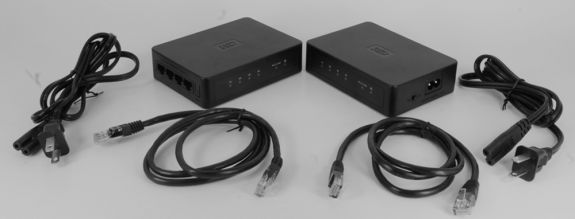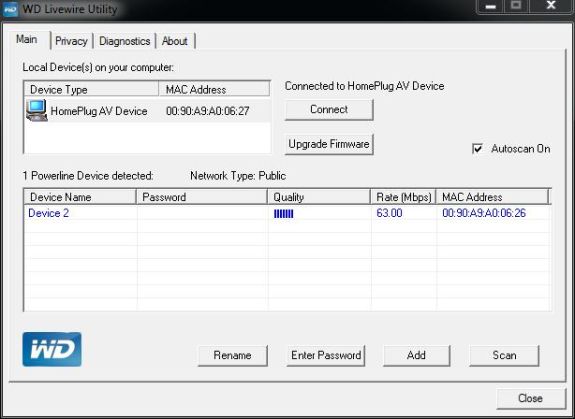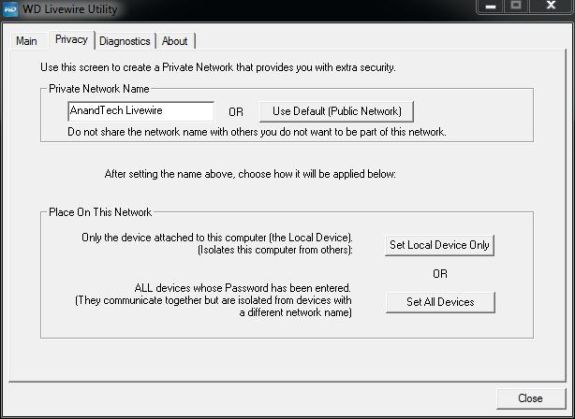Powerline Networking with the Western Digital Livewire
by Ganesh T S on August 24, 2010 7:50 AM EST- Posted in
- Gadgets
- Networking
- Powerline Adapters
The WD Livewire comes in a box with the bare essentials. Unlike the WDTV Live, there aren't as many cables or batteries to deal with. Opening the package reveals a pictorial setup guide, the warranty document and the setup CD. Beneath this, we have a pair of powerline kits. Each kit consists of a 4 port routing unit, along with a short Ethernet cable and an AC power outlet connector. The routing unit is made of black plastic with a WD logo on the top side. It blends well in any sort of setup, and is quite similar in structure to the WDTV Live, except that it is not as thick. This can be seen quite clearly in the photograph below.

Setup CD / Documentation not shown
Setup is very straightforward, even for the non-technical folks. One port of the routing unit is connected to the main router's outlet ports. The other ports in the routing unit (there are 4 ports on each) can be used as an extender for the main router, thereby acting as a port multiplier. This will not be ideal of the router is Gigabit in nature, as all the outlet ports of the routing units in the powerline kits are only Fast Ethernet (100 Mbps). This routing unit is connected to the power outlet. We are not aware of any other powerline adapter kit which can also be used as a port multiplier at the source point (on the main router side).
The other routing unit can be connected to any power outlet in the residence, making available 4 Ethernet ports at that power outlet for usage. It is not hard to imagine requiring four ports at the second power outlet, particularly if it is the entertainment center. A large number of TVs, Blu-Ray players (and the WDTV Live, as well) and other entertainment center components come with an Ethernet port for connecting to the Internet as well as the home network. The package goes to great lengths (to the extent of placing stickers to cover up the power outlet plug point on the routing unit) to make sure that users don't connect it to a power strip or surge protector. This is an advice provided with good intentions, as we personally saw some of the low cost surge protectors halving the available bandwidth. This will be covered in detail in the benchmarking section.
It is not essential to run the installation CD, as we were able to get up and running without it. However, for people who want to secure their powerline network, the installation CD comes with a Livewire utility. As can be seen from the screenshots below, the utility allows firmware updating, and also indicates the powerline kits available on the network (other than the primary one connected to the router). We also get an indication of the bandwidth available on that particular device.
The Privacy tab allows the user to setup a name for the Powerline network, and gives an option to only allow devices on which the password has been entered. The entering of the password referred to in the screenshot actually implies the pressing of the 'Sync' button on all the powerline kits which are intended to become part of the private network. This has to be done for less than 3 seconds on each, but not more than 2 minutes apart.
WD also supplies a 26 page PDF manual with detailed setup and troubleshooting details. All said, the packaging of the kits is professional, and setup is quite straightforward for even the novice users. Most people should get up and running in no time, provided they do not need to mess with private networks of any kind.












31 Comments
View All Comments
PlcBooster - Saturday, September 11, 2010 - link
Hi Souka,Firstly, I would like to convey my Big KUDOS! to Mr. Ganesh T S on his good and inside report on the Powerline Networking with the Western Digital Livewire. He furnished us with very informative good and un bias reports.
I bet many people, end users or rather consumers are quite dismay after they use the PLC adapters and put them into real action ie use at home or at their office.
But hold on your dismay, cos, there is a company in APAC that I know can help or overcome this 10 years inherent issues that have been plaguing these PLC manufacturers, they will be planning to launch their product once they find the right business partner, may be Western Digital Livewire, if WD are keen to explore with them. So that the PLC adapters adoption and acceptance rate will surely flourish worldwide with an affordable price of course. :)
Cheers! to Mr. Ganesh!
PlcBooster - Thursday, December 23, 2010 - link
There is light at the end of the tunnel for all PLC adapters manufacturers, distributors & end usersKindly feel free to view these three short informative videos at the following links below:
PLC-adapters have been proven to perform better with Surestreamer
Part 1
http://www.youtube.com/watch?v=84C7k...eature=rela...
Part 2
http://www.youtube.com/watch?v=fV6Jn...eature=rela...
Part 3
http://www.youtube.com/watch?v=jQuQg...eature=rela...
Thank you very much & Merry Christmas!
casteve - Tuesday, August 24, 2010 - link
Ganesh, thanks for the review. Since WD wants this device to be plugged into the wall and not into a surge protector power strip or UPS:1) How much AC power do the two units use?
2) Do they have an on/off switch?
3) Is there surge protection circuitry built in and are there any guarantees to it? Seems like there would be a surge path via the ethernet ports.
ganeshts - Tuesday, August 24, 2010 - link
casteve,The device acts as a router of sorts, consuming around 3 - 3.5 W. Load or no-load didn't make much of a difference with the Kill-a-watt I was using (it is not really accurate at such low power numbers).
It does have an on-off switch right next to the power connection point.
I will get back to you on the surge protection circuitry in a bit.
ganeshts - Tuesday, August 24, 2010 - link
casteve, I have unofficial confirmation from outside sources that the board design also has surge protection circuitry built in. I am still waiting to hear back officially from WD PR.casteve - Thursday, August 26, 2010 - link
Thanks for the power usage info.yyrkoon - Wednesday, August 25, 2010 - link
Yes, sometimes it is very hard to fish cabling though a wall to get what you want exactly where you need it but come on folks. There are so many neat and tidy ways to run cabling, surely most anyone can find a way to get it done.Such as pulling the floor trim off of the wall, and running cable behind it. Wont work for you ? Raise it up a bit, and run the cabling just under the floor trim(sometimes all that is needed is a wedge, and a screwdriver). Or how about; Under the carpet in the corner of the wall . . . all that is required is a little imagination, and wiliness to spend some time to get it done.
*Or* if things are extremely tough, you can drill a few strategic holes where you *know* you will not cut into anything important ( like power runs or plumbing, etc ), and fish from point A to B to . . .Z. It is not as though doing wall patch work is all that difficult. Again, all that is required is a bit of imagination, and time to achieve. Anyone can make excuses.
I shudder to think of the alternative. Which is *hoping* your electrical is clean / noise free enough to use something that in this persons humble opinion should never have even been given a second thought.
Brucmack - Wednesday, August 25, 2010 - link
I've been using two Amitech home plugs for a while to connect my media box under my TV to the rest of my network. There are a couple of "gotchas" to consider. First, if you have a house with really old wiring, don't expect to get a very stable or fast connection. Second, some chargers can interfere with the signal, especially if you use the homeplug on a power strip. But basically if you can get a stable signal, it's quicker and more reliable than wireless.kwlinca - Wednesday, August 25, 2010 - link
Powerline technology only works when connecting 2 locations on the SAME circuit. My computer is located on one circuit in the front of the house and my AV equipment is located on a different circuit in the back of my house. It is only when you read the fine print that you find this out.Welshtrog - Wednesday, August 25, 2010 - link
The problem with these units is that they are effectively broadband transmitters and cover a large section of the radio spectrum which is why radio users object to their use and objectors can cause them to be removed. by ofcom